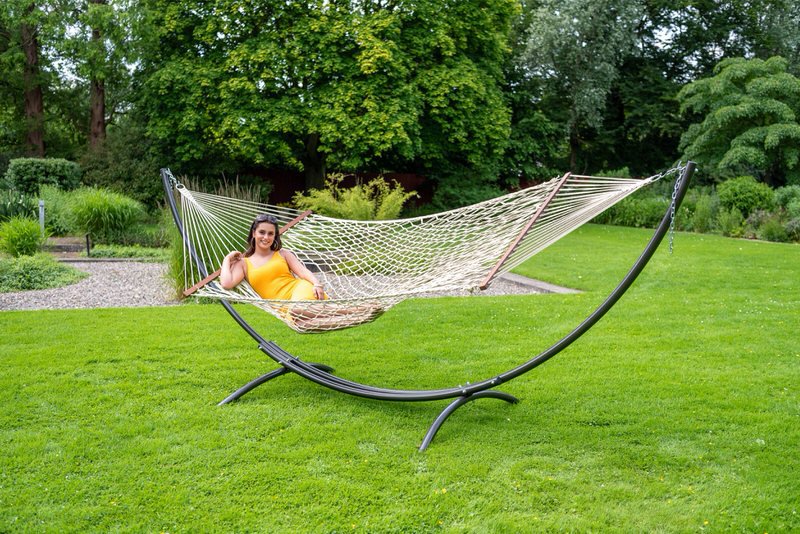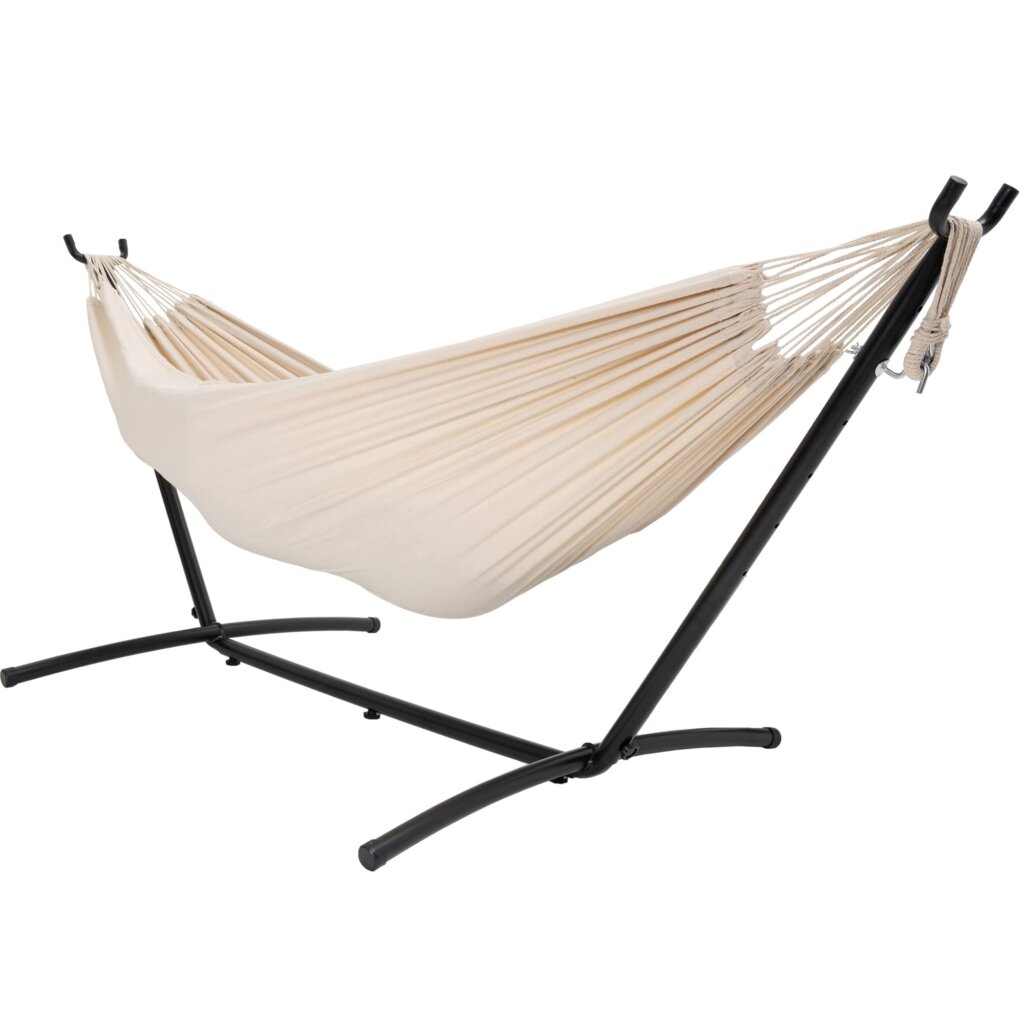- 8 Airplane Footrest Hammock!Travel comfortably - October 9, 2023
- top 7 Pool Float Water Hammock for a Relaxing Summer - October 9, 2023
- top 5 Space SaverSingle Hammock Stand Maximize Comfort and Space - October 9, 2023
Discover the precise measurements for hanging your hammock with the Hammock Hang Calculator. This helpful tool allows you to determine the ideal height, length, and angle for a comfortable and secure hammock setup.
Say goodbye to guesswork and achieve the perfect hang every time.
Importance Of Proper Hammock Hanging
Proper hammock hanging is crucial for a comfortable and enjoyable hammock experience. Whether you’re lounging in your backyard, camping in the great outdoors, or simply taking a break indoors, ensuring that your hammock is securely and correctly hung can make a significant difference in your overall comfort and safety. From maximizing relaxation to avoiding discomfort and injury, there are several reasons why getting the hang of hammock hanging is essential.
Benefits of a well-hung hammock
When it comes to hammock hanging, getting it right has its perks. Here are some of the benefits of a well-hung hammock:
- Optimal comfort: A properly hung hammock offers you the perfect balance between tightness and sag, providing optimal comfort and support for your body.
- Improved sleep quality: A well-hung hammock allows for proper body alignment, reducing pressure points and promoting a deeper and more restful sleep.
- Enhanced relaxation: When your hammock is hung correctly, it allows you to fully relax and unwind, relieving stress and promoting a sense of calm.
- Better blood circulation: A well-hung hammock ensures that your body is positioned in a way that promotes healthy blood circulation, preventing numbness or tingling.
- Reduced strain on joints and muscles: Proper hammock hanging helps distribute your weight evenly, reducing strain on your joints and muscles, especially your spine.
Avoiding discomfort and injury
Poorly hung hammocks can lead to discomfort and even injuries. Here’s why it’s crucial to avoid such risks:
- Back and neck pain: When a hammock is improperly hung, it can cause strain on your back and neck, leading to pain and discomfort.
- Uneven weight distribution: A hammock that is not hung correctly can put excess pressure on certain areas of your body, leading to muscle imbalances and potential injuries.
- Accidental falls: If your hammock is not securely attached or hung too high, it increases the risk of accidental falls, which can result in serious injuries.
- Posture issues: Improperly hung hammocks can strain your posture, leading to alignment problems and long-term discomfort.
Maximizing relaxation and enjoyment
Proper hammock hanging ensures that you can fully maximize your relaxation and enjoyment. Here’s how:
- Stable and secure: A well-hung hammock allows you to relax without worrying about tipping over or feeling unstable.
- Perfectly positioned: Proper hammock hanging ensures that you can find the ideal position and angle for ultimate comfort and relaxation.
- No interruptions: When your hammock is securely and correctly hung, you can fully immerse yourself in your relaxation time without any interruptions.
- Long-lasting enjoyment: Taking the time to properly hang your hammock prolongs its lifespan, allowing you to enjoy it for many years to come.
In conclusion, proper hammock hanging is essential for a comfortable, safe, and enjoyable experience. By ensuring that your hammock is well-hung, you can reap the benefits of optimal comfort, improved sleep quality, enhanced relaxation, and reduced strain on your body. Additionally, avoiding discomfort and injury through correct hanging techniques can prevent back and neck pain, uneven weight distribution, accidental falls, and posture issues. So take the time to master the art of hammock hanging and maximize your relaxation and enjoyment.
Choosing The Right Location
When it comes to hammock hanging, choosing the right location is crucial for a comfortable and safe experience. The right location ensures that you can relax and enjoy the beauty of nature without any worries. Below are some factors to consider when selecting the perfect spot for your hammock hang:
Considering the environment and landscape
Before you set up your hammock, take a moment to consider the environment and landscape around you. Look for an area with a gentle slope, as this will provide a more comfortable and natural position when lying in your hammock. Avoid low-lying areas that can collect water during rain or become muddy.
Additionally, look for a location with sufficient shade, especially if you plan on spending extended periods lounging in your hammock. A spot with dappled sunlight filtering through the trees can create a tranquil and relaxing atmosphere.
Identifying sturdy anchor points
Identifying strong and sturdy anchor points is essential to ensure a safe and secure hammock hang. Look for trees or posts that are at least 6 inches in diameter and show no signs of decay or damage. Avoid trees with loose or dead branches that may pose a risk of falling.
When selecting your anchor points, ensure they are spaced at a distance that will provide adequate tension and support for your hammock. Generally, a distance of 12 to 15 feet between anchor points is ideal, allowing for a comfortable hammock hang without excessive sag.
Avoiding hazards and obstacles
When choosing a location for your hammock hang, it is crucial to be mindful of potential hazards and obstacles. Avoid areas with overhead power lines or branches that may pose a risk of entanglement. Check the ground for rocks, roots, or other sharp objects that could damage your hammock or cause discomfort.
Furthermore, make sure there are no ant nests or other insect habitats nearby. While being in nature is an enjoyable experience, it’s important to avoid unwanted encounters with insects.
To summarize, choosing the right location for your hammock is essential for a comfortable and safe experience. Consider the environment and landscape, identify sturdy anchor points, and avoid hazards and obstacles. By taking these steps, you’ll create the perfect setting for relaxation and serenity in your hammock.
Calculating The Hanging Height
When it comes to hanging your hammock, achieving the ideal hang height is crucial for a comfortable and enjoyable experience. The hang height refers to the distance between the ground and the attachment points of your hammock. Calculating this height accurately ensures proper suspension and prevents discomfort and potential injuries. Let’s explore some factors that affect the ideal hang height and learn how to calculate it correctly.
Factors that affect the ideal hang height
Several factors come into play when determining the ideal hang height for your hammock. Let’s take a look at each of these factors to gain a better understanding:
- Hammock length: The length of your hammock is an essential factor to consider when calculating the hang height. Longer hammocks require a higher hang to maintain a desirable lay and avoid the dreaded “banana” shape that can cause discomfort and strain.
- Preferred sit height: Your preferred sit height also influences the hang height. Sit height refers to the distance between the ground and your seated position in the hammock. Everyone has their own preference for how high or low they like to be in the hammock, so it’s crucial to consider this when determining the hang height.
- Hang angle: The angle at which you hang your hammock affects the hang height as well. A flatter hang angle will require a higher attachment point, while a steeper hang angle requires a lower attachment point. Finding the right balance between comfort and stability is key.
Preferred sit height calculation
To calculate your preferred sit height, follow these simple steps:
- First, sit in your hammock with your feet flat on the ground.
- Measure the distance between the ground and the highest point of your seated position. This measurement represents your preferred sit height.
Now that you have your preferred sit height, you can use it as a reference point to calculate the hang height for your hammock.
Using a known distance or a known height
If you have a known distance or a known height available, you can use it to calculate the hang height more accurately. Here’s how:
- Select a reference point, such as a tree branch or a post, which you know the distance or height of.
- Measure the distance from the ground to the reference point or the height of the reference point.
- Subtract your preferred sit height from the measured distance or height to determine the hang height for your hammock.
By following these steps and considering the factors that affect the ideal hang height, you can ensure a comfortable and safe hammock hang. Remember to always prioritize your comfort and adjust the hang height accordingly. Now, you’re ready to enjoy the ultimate relaxation in your perfectly hung hammock!
Determining Hammock Length
Choosing the right hammock length can make a significant difference in your comfort and overall hammock experience. The length of your hammock affects not only how much room you have to relax, but also your ability to achieve the ideal hang angle and suspension height. In this section, we will explore the factors to consider when choosing hammock length, finding the right length for your body type, and the importance of exploring different suspension options.
Factors to consider when choosing hammock length
When determining the length of your hammock, there are a few key factors to consider:
- Body Length: Your height plays a significant role in choosing the right hammock length. As a general rule, your hammock should be at least 2 feet longer than your height. This allows for proper stretching and comfort.
- Sleeping Position: Your preferred sleeping position also affects the hammock length. If you sleep on your back, a longer hammock may be more suitable to provide enough space for stretching out. If you tend to sleep on your side, a slightly shorter hammock may be more comfortable.
- Hammock Accessories: If you plan on using additional accessories such as underquilts or bug nets, you may need to consider a longer hammock length to accommodate for the extra gear.
- Weight Capacity: It’s important to check the weight capacity of your hammock before choosing a length. A longer hammock may be necessary for individuals with higher body weights.
Finding the right length for your body type
Now that you understand the factors to consider, let’s explore how to determine the right hammock length for your body type:
| Body Length | Recommended Hammock Length |
|---|---|
| Less than 6 feet | 9-10 feet |
| 6-6.5 feet | 10-11 feet |
| 6.5-7 feet | 11-12 feet |
| 7 feet or taller | 12-13 feet |
Keep in mind that these recommendations are just a starting point, and personal preference may vary. It’s always a good idea to test different hammock lengths to find the perfect fit for your body type and comfort needs.
Exploring different suspension options
Once you have determined the ideal hammock length for your body, it’s important to explore different suspension options. The type of suspension you choose can affect the overall hang angle and stability of your hammock. Some popular suspension options include:
- Hammock Straps: These adjustable straps are easy to set up and provide a secure attachment between the hammock and trees or other supports.
- Ridgeline: A ridgeline is a cord that runs between the two attachment points of your hammock and helps maintain the proper hang angle and tension.
- Whoopie Slings: Whoopie slings are lightweight and adjustable suspension ropes that allow for quick and easy setup of your hammock.
- Daisy Chains: Daisy chains are useful for adjusting the height and position of your hammock without having to re-tie knots.
By exploring different suspension options, you can fine-tune your hammock setup to achieve the most comfortable and stable hang. Remember to always follow the manufacturer’s instructions for proper installation and usage of your chosen suspension system.
When determining hammock length, considering factors such as your body length, sleeping position, accessories, and weight capacity is crucial. Finding the right length for your body type and exploring different suspension options can significantly enhance your hammock hang experience. Now that you have the information you need, it’s time to set up your hammock and enjoy the ultimate relaxation.
Achieving The Optimal Hang Angle
Understanding the Importance of Hang Angle
The hang angle plays a crucial role in achieving the ultimate comfort and relaxation while lounging in a hammock. It determines the tension of the fabric, the support provided to your body, and the overall stability of the hammock setup. Understanding the importance of the hang angle is key to ensuring a perfect hammocking experience.
Calculating the Ideal Hang Angle
Calculating the ideal hang angle requires a few measurements and calculations. First, determine the length of your hammock from end to end. This measurement will serve as the baseline for the hang angle calculation. Next, measure the distance between the suspension points, such as trees or hammock stands. Lastly, divide the length of the hammock by the distance between the suspension points to get the hang angle ratio.
| Measurement | Calculation |
|---|---|
| Hammock Length | Measure from end to end |
| Distance Between Suspension Points | Measure from one suspension point to another |
| Hang Angle Ratio | Hammock Length / Distance Between Suspension Points |
Adjusting the Hang Angle for Comfort
While the hang angle ratio provides a starting point, it’s important to adjust the hang angle according to your personal comfort preferences. A hang angle between 30 and 45 degrees is generally considered optimal for most hammocks. However, you can experiment with different angles to find the sweet spot that suits your body type, weight, and preferred lying position.
Here are a few tips for adjusting the hang angle:
- Increasing the hang angle (up to 45 degrees) will promote a deeper sag and a more relaxed position.
- Decreasing the hang angle (closer to 30 degrees) will create a flatter and more taut surface.
- Consider the suspension height (hang height) to ensure it is suitable for easy entry and exit from the hammock.
- Experiment with different hang angles by adjusting the suspension points or using adjustable straps or hardware.
Remember, the optimal hang angle is a personal preference, and it may take a bit of trial and error to find the perfect setup for your hammocking adventures. So go ahead, adjust that hang angle, and get ready to sink into pure hammock bliss!
Ensuring Proper Suspension Length
When it comes to hanging your hammock, ensuring the proper suspension length is crucial for a comfortable and enjoyable experience. The suspension length refers to the distance between the two points where your hammock is attached, such as trees, posts, or hammock stands. Finding the ideal suspension length will allow you to achieve the perfect amount of sag and support, providing you with a relaxing spot to unwind and enjoy the great outdoors.
Before determining the ideal suspension length, it is important to consider the type of suspension system you will be using. There are various options available, including hammock straps, chains, ropes, and webbing. Each suspension system has its own recommended attachment points and weight limits. It is essential to follow the manufacturer’s guidelines and instructions to ensure proper installation and avoid any potential safety hazards.
Once you have identified the type of suspension system you will be using, it’s time to adjust the length for optimal comfort. There are a few factors to consider when determining the ideal suspension length:
- Hammock length: Measure the length of your hammock from end to end, excluding the suspension system. This will give you a baseline measurement for adjusting the suspension length.
- Preferred sit height: Determine your preferred height while sitting in the hammock. This will help you find the right amount of sag and support.
- Hang angle: Consider the hang angle you desire. A wider hang angle will provide more sag and a flatter lay, while a narrower hang angle will give you a tighter and more upright sleeping position.
- Real-world testing: Once you have made initial adjustments, it’s important to test the suspension length in a real-world setting. Get into the hammock and adjust accordingly to achieve the desired comfort and support.
Remember, finding the right suspension length may require some trial and error. Take your time and make small adjustments until you find the perfect setup that meets your comfort preferences.
By following these tips and tricks for ensuring proper suspension length, you can optimize your hammock hang experience and enjoy relaxing moments in nature.
Troubleshooting Common Issues
When it comes to setting up your hammock, it’s important to address any common issues that may arise. Troubleshooting these issues will ensure a comfortable and stable hammock hang experience. In this section, we will discuss the three common issues that hammock users face: addressing hammock sag or tightness, dealing with uneven suspension, and modifying anchor points for better stability.
Addressing Hammock Sag or Tightness
If your hammock sags too much or feels too tight, adjusting the tension can help achieve the perfect hang. Follow these steps to troubleshoot:
- Check the suspension straps or ropes: Ensure that the straps or ropes are properly attached to the anchor points and that they are evenly tensioned. You may need to adjust the length of the suspension to achieve the desired sag or tightness.
- Consider the hang angle: The angle at which your hammock hangs can affect the sag or tightness. Adjust the anchor points to modify the hang angle and find the most comfortable position.
- Try different suspension methods: If your hammock still sags or feels too tight, consider using a different suspension system, such as hammock straps or tree-friendly suspension, to achieve the desired hang.
Dealing with Uneven Suspension
Uneven suspension can cause discomfort and instability when lying in your hammock. Follow these steps to troubleshoot uneven suspension:
- Check the anchor points: Ensure that both anchor points are at the same height and well-secured. If one anchor point is lower than the other, adjust it to match the height of the higher point.
- Inspect the suspension straps or ropes: Make sure that the suspension lines are evenly tensioned between the anchor points. Adjust the length of the suspension to achieve equal tension on both sides.
- Consider using a ridgeline: Attaching a ridgeline between the anchor points can provide additional stability and help maintain even suspension.
Modifying Anchor Points for Better Stability
If your hammock feels unstable or swings excessively, modifying the anchor points can help improve stability. Follow these steps to troubleshoot anchor point stability:
- Choose sturdy anchor points: Make sure that the anchor points, such as trees or posts, are sturdy and able to support the weight of your hammock. Avoid using weak or unstable anchor points.
- Consider using additional support: If the anchor points alone are not providing enough stability, consider using additional support, such as tree straps or a hammock stand, to reinforce the anchor points.
- Adjust the distance between anchor points: Experiment with different distances between the anchor points to find the most stable setup. A shorter distance may provide better stability, while a longer distance can increase swing and freedom of movement.
By addressing hammock sag or tightness, dealing with uneven suspension, and modifying anchor points for better stability, you can troubleshoot and resolve common issues for a more enjoyable hammock hang experience.
Fine-Tuning Your Hammock Setup
Fine-tuning your hammock setup is essential to creating your ideal hanging experience. Adjusting the height and angle, adding accessories for extra comfort, and fine-tuning for a perfect hang will ensure that you can relax and enjoy your hammock to the fullest.
Adjusting the height and angle for different preferences
When it comes to setting up your hammock, finding the right balance is key. Adjusting the height and angle of your hammock can make a significant difference in your comfort level and overall experience. To determine the ideal height, consider your preferred sit height, which is the distance from the ground to the lowest part of the hammock when you are seated. This will vary depending on your personal preference and how you like to lounge in your hammock.
To adjust the height, start by securing one end of your hammock to a sturdy anchor point, such as a tree or a hammock stand. Then, decide on the desired sit height and adjust the other end accordingly. It may require some trial and error to find the perfect height that allows for maximum relaxation.
In addition to adjusting the height, you can also fine-tune the angle of your hammock. The hang angle refers to the angle between the suspension and the ground. A 30-degree angle is generally recommended for a comfortable and supportive hang. However, you can experiment with different angles to find what feels best for you.
Adding accessories for extra comfort
To enhance your hammock experience, consider adding accessories that can provide extra comfort and convenience. Here are some popular options:
- Hammock straps: These straps allow for easy setup and provide additional stability and adjustability.
- Rainfly: A rainfly is a protective covering that can shield you from rain or excessive sun exposure. It’s especially useful for camping or extended outdoor use.
- Mosquito net: A mosquito net can keep pesky bugs at bay, allowing you to relax without worrying about insect bites.
- Pillows and blankets: Adding pillows or blankets can make your hammock even cozier and provide extra support for your head and body.
- Drink holders or storage pockets: These accessories allow you to keep essentials, such as a water bottle or a book, within easy reach.
Fine-tuning for a perfect hang experience
Once you have adjusted the height, angle, and added your desired accessories, it’s important to fine-tune your setup for a perfect hang experience. Here are some additional tips:
- Check the tension of your suspension system to ensure that it provides adequate support without sagging or being too tight.
- Make sure your hammock is evenly spread and not twisted to prevent discomfort and strain.
- Test different positions within the hammock to find the most comfortable one for you.
- Use a ridgeline to achieve a consistent sag in your hammock and prevent excessive stretching.
- Regularly inspect your hammock and accessories for any signs of wear or damage and replace them as needed.
By following these steps, you can fine-tune your hammock setup to create the perfect hang experience tailored to your preferences. Take the time to experiment and find what works best for you, and soon you’ll be enjoying hours of blissful relaxation in your hammock.
Real-World Examples And Practical Tips
Case Studies of Different Hanging Scenarios
When it comes to hanging a hammock, every scenario is unique. Whether you’re setting up your hammock in the backyard, at the beach, or during a camping trip, it’s essential to understand how different factors affect the hanging process. Here are some real-world case studies that will provide you with valuable insights:
- Backyard Hammock Hang: Learn how to find the perfect spot, measure the distance between anchor points, and adjust the hang angle for maximum comfort.
- Beach Hammock Hang: Discover the challenges of hanging a hammock on sandy terrain and tips for securing your hammock in windy conditions.
- Camping Hammock Hang: Explore various suspension systems, ideal ridgeline length, and how to hang your hammock in different types of trees.
Tips from Experienced Hammock Users
Get advice from experienced hammock users who have perfected the art of hanging. These practical tips will help you enhance your hammock hang experience:
- Choose the right suspension system: Select a suspension system that suits your needs and provides the desired level of adjustability.
- Consider the hammock length: Ensure your hammock is long enough to accommodate your height comfortably.
- Find the optimal hang angle: Experiment with different hang angles to achieve the most comfortable position.
- Use a ridgeline: Utilize a ridgeline to achieve consistent sag when setting up your hammock.
- Check the weight capacity: Before hanging, make sure your hammock can support your weight and any additional accessories or gear.
FAQs and Answers for Common Hanging Questions
Here are some frequently asked questions about hanging a hammock, along with their answers:
- How do you measure to hang a hammock? To measure your hammock correctly, follow our step-by-step guide: (Include relevant information from the YouTube video link).
- How high do I hang my hammock? Use our Hammock Hang Calculator to determine the ideal height for hanging your hammock and achieving the perfect balance of comfort and stability.
Have more questions? Leave a comment below, and we’ll be happy to help!

Credit: www.hammockuniverse.com
Frequently Asked Questions Of Hammock Hang. Calculator | Tips And Tricks
How Do You Measure To Hang A Hammock?
To measure to hang a hammock correctly, you can use a hammock hang calculator. It helps you determine the ideal hang height, hang angle, suspension length, and other factors based on your preferences and hammock type. This ensures a comfortable and secure setup.
How High Do I Hang My Hammock?
To determine the perfect height for your hammock, use a reliable hammock hang calculator. This helpful tool will consider various factors such as the hang point or distance, suspension length, and forces involved. Using a calculator ensures optimal comfort and safety while enjoying your hammock.
What Is The Correct Sag For A Hammock?
The correct sag for a hammock can be determined using a hammock hang calculator. This tool helps estimate the hang point or hang distance, suspension length, and forces at play with different types of hammocks. It is important to use a calculator to ensure proper setup and comfort while using a hammock.
How Far Apart Should Anchors Be For Hammock?
The anchors for a hammock should be spaced apart at a distance equivalent to the overall length of the hammock.
How Do I Measure To Hang A Hammock Properly?
To measure your hammock correctly, ensure you have enough distance between anchors. Use a measuring tape and make sure it’s tight for an accurate measurement.
How High Should I Hang My Hammock For Optimal Comfort?
To achieve maximum comfort, hang your hammock at a height that allows it to hang with a slight sag. This relaxed position will provide the best experience.
Conclusion
The Hammock Hang Calculator is a valuable tool for anyone looking to hang their hammock with precision and comfort. With step-by-step guides and important measurements, this calculator ensures optimal hang height, suspension length, and hang angle. By using this calculator, you can enjoy the perfect hammock experience every time, whether you’re camping or simply relaxing in your backyard.
Say goodbye to the guesswork and hello to ultimate comfort with the Hammock Hang Calculator.





